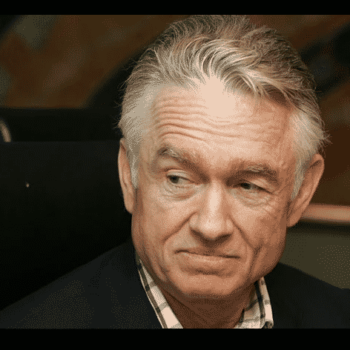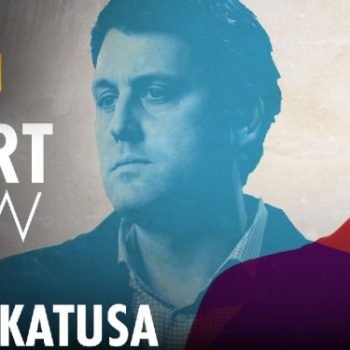
When it comes evaluating and buying gold assets, few, if any, people know more than my friend Rob McEwen. Rob is the extremely successful founder and former CEO of gold giant Goldcorp. He’s a member of the Canadian Mining Hall of Fame and the current CEO of McEwen Mining. Recently, I discussed gold acquisitions with Rob and even got him to mention some of his top junior gold stock holdings. Below, you’ll find insights from one of the gold world’s greatest dealmakers.
Marin Katusa: I’m here with Rob McEwen, a legend in the gold mining business. Rob, thanks for doing this for my subscribers. First question: where are we currently in the gold market when it comes to the spot price of gold?
Rob McEwen: We are in the early stage of a major uptrend. There are a number of reasons for this: one is the extreme amount of debt that has already been incurred by governments around the world. It is rapidly becoming a larger burden that will eventually become unmanageable. I expect to see widespread devaluation of currencies relative to gold.
Combine that with some geopolitical strife and economic problems floating around the world, and you are going to see more people turning towards gold as a form of insurance for the balance of their wealth. It’ll once again be used as it has been used for millennia: to preserve value, the ultimate currency.
Marin Katusa: I am with you 100 percent. I think we are in the early part of the gold “glory days.” I think gold is well-positioned to have a great run this year. The President of the United States just stated that the USD is overvalued, so you know we are in for an interesting year for currencies and gold. Where do you see the price of gold in the next 12 months and in the next 5 years?
Rob McEwen: Let me answer the second question first; In five years, we are going to be at $5,000 an ounce. This year I am expecting a higher price by the end of the year than gold is at now, possibly $2,000/oz.
Marin Katusa: Gold is a great hedge against the future value of a fiat currency, whether it’s the US dollar, the Euro or the Yen. A great example of this was what happened to the Russian Ruble from late 2014 and during 2015, where the Russian currency dropped in value by 50%, but those who had gold were protected by the currency depreciation. A lot of people say gold will do incredibly well in an inflationary market.
But if we enter a period of global deflation, I believe that gold will still do well; whereas the old argument was…it’s about inflation. What’s your opinion there?
Rob McEwen: I agree with you. In a deflationary environment, gold offers extreme liquidity. I’ll give you an example. Let’s compare having your money in gold or in real estate. If you want to sell your house, it is virtually impossible to sell it and get your money in two days. Gold, on the other hand, you can sell in two days and achieve instant liquidity. It offers that form of insurance in a deflationary environment where it gives its holder a clear advantage over most other asset classes.
Marin Katusa: I totally agree. We all saw that in 2008 when liquidity just went away.
Rob McEwen: Yes.
Marin Katusa: So you and I are on the same page when it comes to the price of gold. Now as the founder of Goldcorp – the second largest gold producer today – and the Chief Owner of McEwen Mining, you’re a legend in the gold business. You are no stranger to M&A, mergers and acquisitions. We’ve seen a flurry of PP’s by majors into juniors whether its Goldcorp, Agnico, Barrick, or the recent take out of some of these juniors’ non-producing gold companies. Do you see further consolidation in the gold space, or do you think the majors have kind of bit off what they need to chew for the next few years?
Rob McEwen: The majors now see the juniors as a sweet spot in the market. They bloated their balance sheets with debt from 2005 up to 2012. Then gold and silver prices collapsed and suddenly their revenues were insufficient to service their debt. The way of dealing with the problem was selling properties and drastically cutting back their exploration budgets. As a result, most majors, now have negative growth profiles.
So to deal with this falling production curve, they have to come up with some excitement for their shareholders. They have to be able to say “we have growth in these other areas”, and that’s why we see them jumping into the junior space. They are aggressively looking for the juniors with potential and also looking at geopolitical areas closer to home where there seems to be a district developing. Look at the Yukon and what Goldcorp’s doing. It bought Kaminak and some others immediately around Kaminak. They are consolidating properties in safer jurisdictions.
Marin Katusa: And district scale potential…
Rob McEwen: …in communities that are more predictable and closer to home.
Marin Katusa: I think the sweet spot here is going to be the mid-tiers. I personally believe that there is going to be consolidation in the mid-tiers, where mid-tiers is defined as between 100,000-1,000,000 ounces of annual production. Do you see active M&A within the mid-tier gold producer sector?
Rob McEwen: Absolutely. The mid-tiers’ production curve is going up. The seniors’ production curve is going down. So the performance is going to be in the mid-tiers and the juniors. But the mid-tiers need to get size as the market has become increasingly dominated by passive investment through ETFs, rather than active investment managers.
The number of the indices that the company is in is going to increasingly determine the volume and market liquidity of a company’s shares. Therefore, some mid-tiers are probably going to be looking for stocks that are ignored by the indices and ETFs. So if you have a good project that’s got room to grow and you’re not in a lot of indices, you might want to be looking over your shoulder or people should look at you to buy before the bigger guy steps in.
Marin Katusa: That’s a perfect segue into my next question. When Rob McEwen is the head of a company as a corporate, what are the key items you would like your corporation to look at when you are evaluating a potential takeover candidate? Let’s say, what are the five key important items?
Rob McEwen: I’ll look at management and what their past successes have been.
I’ll look at how much commitment they have made to the company financially. How many shares do they own and what is their cost of those shares? How many options have they been granted? Do they grant themselves a lot of options, and do they pay themselves excessively? If they are frugal with their options and their compensation and they have an interesting business plan, I go “Okay, I like that.”
Are they any good at math, and what’s their view of the future? In other words, have they gone out and sold royalties on their property? Have they sold metal streams? Have they hedged their future? And if they’re telling me they’ve got the best story out there and it’s going to keep growing and they also believe gold is going higher but they’ve sold a stream or royalties or hedged then I know they are talking from both sides of their mouth and I don’t invest.
Marin Katusa: This is Rob McEwen as an investor – what about Rob McEwen as a corporate entity?
Rob McEwen: The same rules apply because if management is out promoting and saying gold’s going higher and the value of their assets is going to benefit significantly. Then they should be exercising discipline and not giving in to that temptation to take money from a metal streaming company or royalty company or to hedge their future production. They should be preserving as much of the price upside as possible for their share owners.
Marin Katusa: What other key factors do you look for?
Rob McEwen: The strip ratio. What is the cost of moving all this material? I’ve always been a big fan of grade. In fact, I have probably focused too much on grade, having being spoiled by Goldcorp’s grades.
Marin Katusa: The Red Lake mines have truly been phenomenal grade.
Rob McEwen: …and look at the profit margins. An area that investors should take more time looking at is the company’s ownership of property and what payments might be required. Because often a company may say “Well, we got this property.” But perhaps they don’t own it or there are large outstanding payment yet to be made. Have they just optioned the property and have to make more payments? You need to ask if the property is owned and fully paid for. This isn’t usually in a presentation; you have to dig into the documentation.
Marin Katusa: I agree. I love this line – I don’t know where I picked it up years ago – grade is king and oxide is queen. Do you look at and do you prefer certain types of geology over others? Do you prefer open pits over undergrounds? Do you prefer oxides over sulphides, or do you just look at project specifics for your situation?
Rob McEwen: Project specifics and profitability.
Marin Katusa: It’s all about the profitability. Are there any other items that you look at, that you think investors should learn about and focus on, such as metallurgy, safety records, district scale potential and the ability to increase production?
Rob McEwen: All of those are also very critical. On a private basis, I will go much earlier stage. I am prepared to take more risk on a property if I like the concept.
P.S. Stay tuned tomorrow, because in Part 2 of the Q&A Rob will reveal to you the junior companies he’s looking at and investing his own money in.






